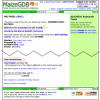The maize genetics and genomics database. The community resource for access to diverse maize data
- PMID: 15888678
- PMCID: PMC1104160
- DOI: 10.1104/pp.104.059196
The maize genetics and genomics database. The community resource for access to diverse maize data
Abstract
The Maize Genetics and Genomics Database (MaizeGDB) serves the maize (Zea mays) research community by making a wealth of genetics and genomics data available through an intuitive Web-based interface. The goals of the MaizeGDB project are 3-fold: to provide a central repository for public maize information; to present the data through the MaizeGDB Web site in a way that recapitulates biological relationships; and to provide an array of computational tools that address biological questions in an easy-to-use manner at the site. In addition to these primary tasks, MaizeGDB team members also serve the community of maize geneticists by lending technical support for community activities, including the annual Maize Genetics Conference and various workshops, teaching researchers to use both the MaizeGDB Web site and Community Curation Tools, and engaging in collaboration with individual research groups to make their unique data types available through MaizeGDB.
Figures


Comment in
-
Biological databases for plant research.Plant Physiol. 2005 May;138(1):1-3. doi: 10.1104/pp.104.900158. Plant Physiol. 2005. PMID: 15888672 Free PMC article. No abstract available.
References
-
- Barker G, Batley J, O'Sullivan H, Edwards KJ, Edwards D (2003) Redundancy based detection of sequence polymorphisms in expressed sequence tag data using autoSNP. Bioinformatics 19: 421–422 - PubMed
-
- Brendel V, Xing L, Zhu W (2004) Gene structure prediction from consensus spliced alignment of multiple ESTs matching the same genomic locus. Bioinformatics 20: 1157–1169 - PubMed
-
- Bruskiewich R, Coe EH, Jaiswal P, McCouch S, Polacco M, Stein L, Vincent L, Ware D (2002) The Plant OntologyTM Consortium and plant ontologies. Comp Funct Genomics 3: 137–142
Publication types
MeSH terms
LinkOut - more resources
Full Text Sources
Other Literature Sources

